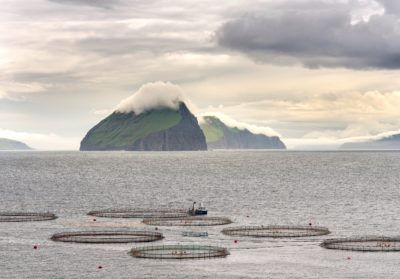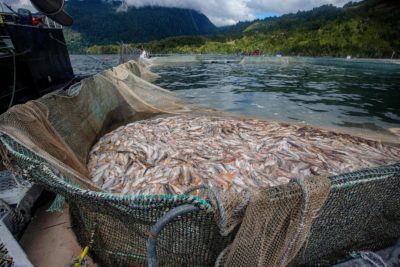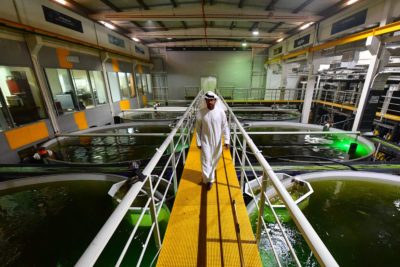Whether roaming wild or enclosed in floating feedlots on the ocean, Atlantic salmon are cold-water fishes. But as the climate crisis warms the world’s oceans and waterways, cold water is becoming harder to find, which means these long-endangered fish are facing perhaps their biggest challenge yet.
Atlantic salmon are anadromous, moving between freshwater and saltwater environments. For millennia, they spawned in the rivers of the northeastern United States, eastern Canada, and Northern Europe before migrating to the coasts of Greenland and Iceland. There, they grew to maturity before returning to their natal rivers to give birth to new generations.
The journey has long been perilous. Pollution, dams, overfishing, and habitat destruction have diminished the number of Atlantic salmon since the dawn of the Industrial Revolution. Salmon runs that once numbered in the tens of millions have disappeared, and wild salmon have nearly disappeared from all of their ancestral waters. Climate change poses a potent new threat to both wild salmon and those contained inside industrial pens.
For two decades, researchers have documented far-reaching damage to ocean ecosystems from rising water temperatures. Figures from the North Atlantic Salmon Conservation Organization, a nonprofit, illustrate one aspect of the impact. Prior to 1990, only a single fish out of 1,000 fertilized eggs survived its first year at sea. From 2007 to 2016, that single salmon required 2,000 eggs.
NOAA warns that climate change represents a potential extinction-level danger to some species of wild salmon.
The danger extends beyond the marine environment. A study by the state of Washington in 2020 found that as the air warms, snowmelts dwindle, and droughts increase, less cold water remains in streams and rivers in summer, when salmon need it the most.
Warmer water also contains less oxygen, which makes it harder for salmon to breathe. Temperatures above 64 degrees F (18 degrees C) speed up the salmon’s metabolism, increasing the need for oxygen and forcing the fish to expend more energy to swim farther in search of food and cooler water.
With global warming predicted to intensify, the National Oceanic and Atmospheric Administration has warned that climate change represents a potential extinction-level danger to some species of wild salmon.
Bill Taylor, president of the Atlantic Salmon Federation, a nongovernmental group dedicated to protecting wild salmon and restoring their habitats, shares that fear. “Climate change is the biggest impact right now on salmon, and it will be for decades to come,” Taylor told us. “It has a direct impact from the headwater streams to the feeding grounds off western Greenland. Salmon is just one species affected by climate change, but we see it as the canary in the coal mine.”
A salmon farm off the Faroe Islands in the North Atlantic.
Martin Zwick / REDA&CO / Universal Images Group via Getty Images
Wild salmon have struggled against the odds for decades and now must adapt yet again. Marine biologists have recently tracked both Pacific and Atlantic salmon to the Arctic in search of colder water. These so-called “thermal migrants” could open a new chapter in the evolution of this keystone species, provided the fish can adapt before the climate clock runs out.
Farmed salmon, of course, face similar climate-related pressures. But unlike their wild relatives, they have no hope of migrating to cooler water. Since farmed salmon cannot adapt, the aquaculture industry itself must change — or face its own decline.
The risk to the industry was explained concisely in Dead Loss, a 2021 study by Just Economics, a research organization in the United Kingdom. “Atlantic salmon can only be farmed under certain conditions and as seas warm and available locations become exploited, the industry is running out of viable sites for new farms,” the study said. “This means that new sources of growth are dwindling, creating pressures to locate farms in less suitable environments and to increase stocking densities, which further exacerbate environmental pressures.”
We spent two years examining the practices of the $20-billion global salmon farming industry for our recently published book, Salmon Wars: The Dark Underbelly of Our Favorite Fish. We interviewed scientists, physicians, environmentalists, and people in the aquaculture business. Climate change emerged as one of the most critical environmental and fish welfare challenges to salmon farmers, raising doubts about the industry’s future on the warming oceans.
A 2019 die-off of farmed salmon in Canada was primarily caused by higher water temperatures, researchers say.
Since its origins in the late 1960s and early 1970s in Norwegian fjords, open net pen salmon farming has become the world’s fastest-growing food sector, providing as much as 90 percent of the Atlantic salmon eaten in North America. A handful of multinational corporations dominate the business and produce 96 percent of the world’s farmed salmon in four regions — Norway, Chile, Canada, and Scotland. Small numbers of farms are located off the coasts of Maine, Ireland, Tasmania, and the Faroe Islands.
The industry’s rapid expansion and intensive farming methods have generated considerable controversy. While the industry promotes its product as sustainable, some scientists and conservation groups question the farms’ impacts on both the environment and fish welfare.
A typical open-net pen salmon farm consists of 12 to 16 cages made from reinforced plastic nets, which are approximately 400 feet in circumference and about 30 feet deep. The nets are suspended by floatation collars and attached to the seabed by steel cables, which allow the installation to move with the current and tides. A single farm can hold a million or more salmon.
From the surface, salmon farms appear innocuous. Below the water line, cages are so crowded that they become breeding grounds for viruses and diseases. Because farms are often located on salmon migration routes, the spread of diseases and parasites like sea lice endanger wild fish. Excess feed, excrement, and residue from pesticides and other chemicals often accumulate below the farms.
Salmon killed in a mass die-off at Porcelana farms in southern Chile in 2021.
ALVARO VIDAL / AFP via Getty Images
The problems created by industrial-scale aquaculture have increased in tandem with ocean temperatures. The clearest impact can be seen in the increasing number and size of mass mortalities at salmon farms in eastern Canada, Norway, Chile, and Ireland, according to a study by Spheric Research, a consultancy specializing in sustainable food systems.
Mortality rates for farmed Atlantic salmon are estimated at between 15 and 20 percent globally. (By contrast, factory chickens have a mortality rate of 5 percent.) But in recent years the salmon industry has, in some places, suffered far higher rates.
A record die-off occurred in late summer of 2019 off the southwestern coast of Newfoundland, wiping out 2.6 million fish at 10 of Northern Harvest Sea Farm’s operations — nearly half of the operator’s fish. The company blamed the deaths solely on an extended period of ocean temperatures reaching 70 degrees F (21 degrees C). As the surface water warmed, the fish sought refuge in cooler water at the bottom of the cages, where they suffocated from lack of oxygen.
The Fisheries and Marine Institute at Memorial University investigated the die-off and found the increase in water temperatures was the primary cause. But warmer water, the study said, was only one element in a “spiral of worsening conditions” inside the net pens. The use of pesticides to fight parasites had stressed the fish before the arrival of the warm water, and algae blooms in the bays had further depleted oxygen levels.
Scientists do not know if wild salmon can move to cooler water fast enough to survive warming oceans.
Similar concerns have been raised elsewhere. A 2021 study in the Journal of Marine Science concluded that warmer water was increasing infestations of sea lice and rendering the usual pesticides ineffective. A 2022 study by the U.S. Environmental Protection Agency found warming water also increases the frequency of harmful algae blooms. The agency noted that marine animals must leave the affected areas to survive. Again, farmed salmon don’t have that option.
The industry counters critics by claiming that salmon farms can meet the world’s growing protein crisis. A study by the University of British Columbia’s Institute for the Oceans and Fisheries, however, predicted that aquaculture production — including farmed salmon — in many locations and under a high-emissions scenario will drop by up to 90 percent by mid-century due to the direct impact of ocean warming and the indirect damage to forage fish, essential to the industry as salmon feed.
Some multinational salmon farming corporations are racing to get ahead of warming oceans. Rival companies in Norway are fighting to move their farms to the country’s northernmost fjords. Innovasea, based in Boston, has developed a submersible fish pen that can be lowered to avoid warm surface water and keep fish at optimal temperatures. Researchers in Norway and Australia are taking another route, trying to breed salmon that would better resist heat.
Fish Farm, in the United Arab Emirates, is one of a growing number of land-based projects where Atlantic salmon are raised in tanks.
GIUSEPPE CACACE / AFP via Getty Images
Meanwhile, a radical alternative to ocean salmon farms is emerging. Recirculating aquaculture systems, known as RAS, raise Atlantic salmon in large tanks on land. The water is filtered to remove contaminants, allowing the fish to grow without chemicals. The closed-containment systems ensure that the fish never touch the ocean, which erases any threat to wild salmon or other marine life.
Independent RAS projects are popping up in landlocked places, including Switzerland and the United Arab Emirates. The largest plant, called Atlantic Sapphire, lies about 13 miles inland from Florida’s east coast. The most innovative plant may be Superior Fresh, in Wisconsin, which raises its salmon only in freshwater, allowing the facility to recycle the nutrient-rich water to a nearly 13-acre greenhouse that hydroponically produces leafy green vegetables.
No one knows whether wild salmon can move to cooler water fast enough to avoid succumbing to warming oceans. But some who are studying the new movements are optimistic.
“Salmon have an amazing ability to adapt to harsh conditions,” said Karen Dunmall, a marine biologist with Canada’s Department of Fisheries and Oceans who studies salmon migration northward. “Salmon are doing what salmon do. They access new places and try to figure out how they can establish themselves.”



